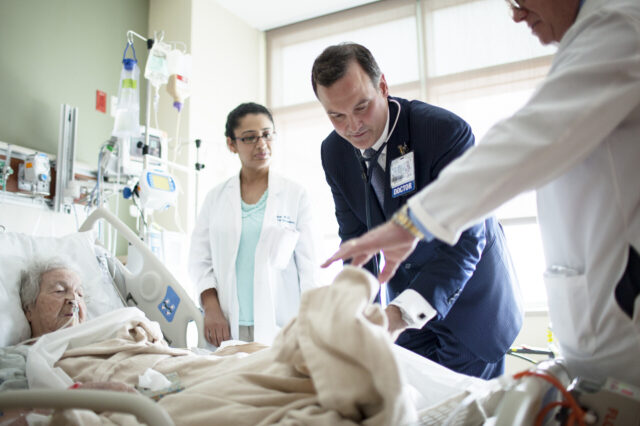Embedded geriatrics consults mean healthier patients, according to UF Health study

When older adults have access to a geriatrician in the hospital, they are much less likely to die and more frequently leave the hospital healthier, according to a study UF Health researchers presented today (May 15) at the annual meeting of the American Geriatrics Society.
The study, led by Laurence M. Solberg, M.D., the chief of the division of geriatric medicine in the UF College of Medicine, examined what happens when a hospital embeds geriatricians to help older adults with their care as soon as they come through the hospital doors. He found that the mortality rate of older patients in the trauma unit dropped by 50 percent and by 58 percent in the units where patients with chronic illness receive care. The research team also found a 4 percent increase in patients being able to go home after treatment, bypassing a long-term care facility.
Solberg, a fellow of the American Geriatrics Society, was hired in August 2013 to increase the presence of geriatric clinical services at the UF College of Medicine. He started a geriatrics consult service with a novel model of care he called “the embedded geriatrician” at UF Health Shands Hospital, joining Frederick A. Moore, M.D., UF Health’s chief of acute care surgery in the College of Medicine’s department of surgery and a co-author of the paper.
“The idea was to assist with the management of older trauma patients. Then we expanded the concept of the embedded geriatrician consult service to include other hospital services, partnering with the hospitalist service of physicians who provide inpatient care to patients with chronic illness or health problems,” said Solberg, also an associate professor in the Institute on Aging’s department of aging and geriatric research.
Several factors boost the admission of older patients to Florida hospitals, including Florida’s robust retiree populations and the aging baby boomer generation. Because of their changing physiology, patients 65 and older may benefit from physicians called geriatricians who are specially trained in the care of older adults, according to Solberg and Moore.
“They’re not quite as resilient as younger people,” Moore said.
Older adults also often have additional diseases such as chronic obstructive pulmonary disease, congestive heart failure and poor kidney function, Moore said. Geriatricians are trained in caring for these older adults whose chronic diseases may require several medications, and in how certain medications affect older patients. Geriatricians look at older people from a holistic approach and focus on functional abilities, quality of life and decreasing medications patients may be taking, according to Solberg.
As part of the embedded geriatrician consult service Solberg developed, physicians consult with patients to set a plan of care, including following the Beers Criteria, a list of potentially inappropriate medications for older adults recently updated by the American Geriatrics Society. The consult service also recommends rehabilitation therapists working with older patients early during the hospital stay to become active more quickly to help regain mobility they may have lost from their illness or accident, Solberg said.
To determine the impact of these consults, the researchers examined hospital data from 21,615 patients 65 and older. Their study began 1.7 years before beginning the embedded geriatrician consult service and continued 1.3 years after the start of the consult service. A total of 589 patients received consults, including 294 who were admitted to the trauma unit.
The researchers found that while patients’ length of stay did not change in the trauma unit, 4 percent more older adults were sent home from general medical units rather than to a long-term care facility. The patient death rate fell as well. In the trauma unit, the patient mortality rate dropped from 14.9 percent to 7.1 percent. In the other inpatient medical units, the mortality rate fell from 13.4 percent to 5.7 percent.
Another benefit of the embedded geriatrician consult service has been placing patients who need short-term rehabilitation care in facilities that better fit their recovery needs.
“One of the good things they’ve done is decreased their length of stay and then increased number of patients going to facilities that are capable of providing rehabilitation,” Moore said.
Approximately 1 percent of hospitals in the United States had services dedicated to taking care of older adults, according to surveys conducted in 2014 by the geriatric trauma committee in the American Association for the Surgery of Trauma. In 2014, UF Health added a second embedded geriatrician, Jacobo Hincapie Echeverrie, M.D., to expand the capabilities of the embedded geriatrician consult service.
“These geriatricians come in, consult with patients, develop a plan of care and provide their expertise,” Moore said. “Now, we have more troops on the ground thinking about how we’re going to care for our older patients.”